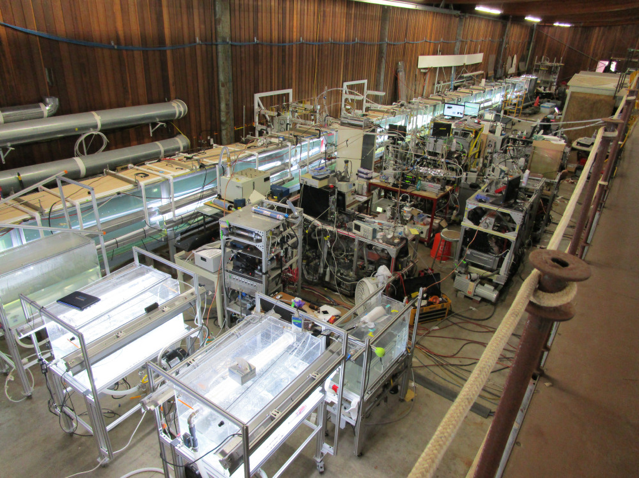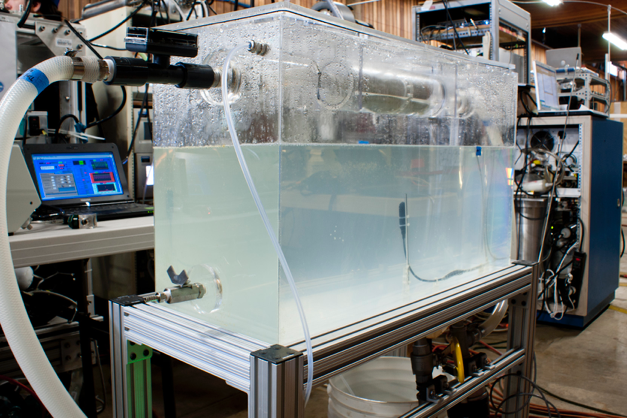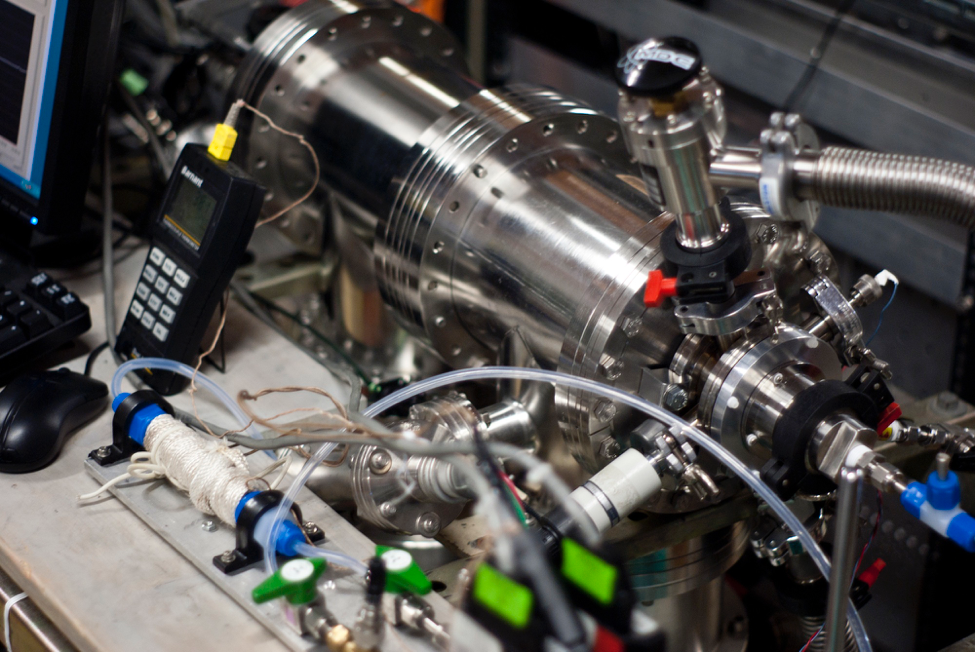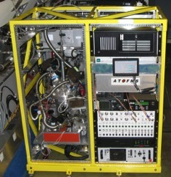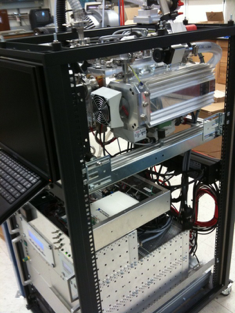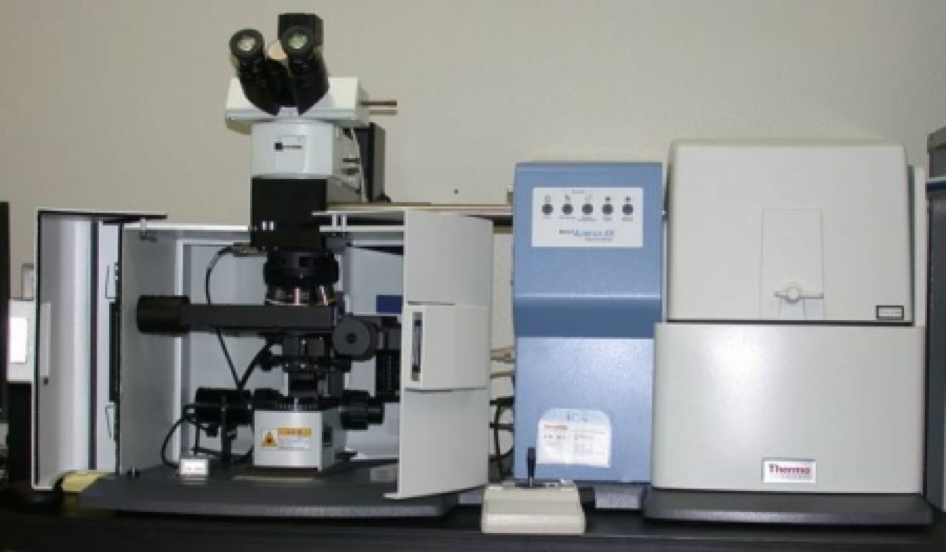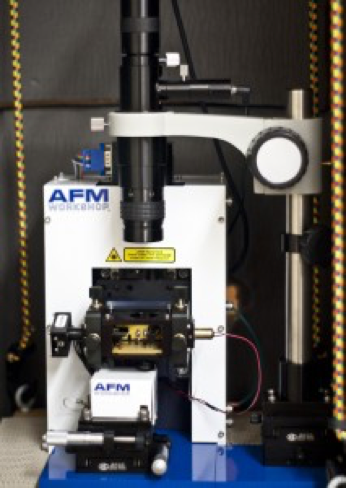Our Science
CAICE investigators perform cutting edge research on complex aerosol chemistry.
Tools
Sea Spray Generators
In order to properly reproduce the properties of aerosol particles generated in nature, it is essential to accurately mimic the mechanisms that create them. Towards this goal, an artificial ocean was created in the glass wave channel in the Scripps Institution of Oceanography Hydraulics Laboratory. In Phase I, real seawater from off the Scripps Pier was transported to fill the 33m x 0.5m x 0.5m tank. Wave packets were generated using an electro-hydraulic powered paddle to mimic the wave properties and bubble size distribution encountered in nature. The tank was sealed and filtered air was directed through the channel to provide a clean background from which to measure the properties of particles generated during the process. Beyond measuring properties of particles generated from clean seawater, biological material can easily be added to simulate increased concentrations of eukaryotes, bacteria, and organic carbon in order to probe the impacts of changing seawater composition on aerosol properties. This experimental setup has allowed for the first measurement of the chemical properties of nascent sea spray.
Marine Aerosol Reference Tank (MART) System
For smaller scale, focused studies, it is beneficial to have a generation mechanism that can be easily manipulated to probe fine level variations and can be effectively reproduced at numerous locations. The design of the MART system accomplishes these goals by using the lessons learned during experimentation with the glass walled wave channel to properly reproduce the properties of sea spray. There are currently three iterations of the MART tank system.
- The first generation model for smaller experimental systems.
- A larger version for increased particle production capabilities.
- A duplicate of the larger tank optimized for measurements of the physical properties of the wave simulation system.
For smaller scale, focused studies, it is beneficial to have a generation mechanism that can be easily manipulated to probe fine level variations and can be effectively reproduced at numerous locations. The design of the MART system accomplishes these goals by using the lessons learned during experimentation with the glass walled wave channel to properly reproduce the properties of sea spray. There are currently three iterations of the MART tank system.
- The first generation model for smaller experimental systems.
- A larger version for increased particle production capabilities.
- A duplicate of the larger tank optimized for measurements of the physical properties of the wave simulation system.
Related Publications
Mass Spectrometry
The amount of material contained within a single aerosol particle is about one trillionth of a gram. Many important reactive trace gases in the atmosphere exist as only one 1 molecule in a billion molecules of whole air. As one of the most sensitive chemical analysis techniques, mass spectrometry is well suited to the task.
Aerosol Time-of-Flight Mass Spectrometry (ATOFMS)
The ATOFMS is a mass spectrometer developed by the Prather Research Group that is capable of measuring the size and composition of individual aerosol particles, returning the results in real time. Particles are introduced to the instrument where they are intercepted by an ultraviolet (266 nm) laser pulse, which causes the components of the particle to vaporize and ionize. The ATOFMS is equipped with two time-of-flight mass spectrometers: both the positive and negative ions produced by photo-ionization can be detected. These unique instruments can help determine whether chemicals are mixed together in the same particle (‘internally mixed’) or if the various compounds detected are in different particles (‘externally mixed’). This concept of mixing state is important in the cloud forming potential of atmospheric aerosols, for instance, and techniques that measure individual particles, like ATOFMS, are uniquely suited to resolve aerosol mixing state.
The ATOFMS is a mass spectrometer developed by the Prather Research Group that is capable of measuring the size and composition of individual aerosol particles, returning the results in real time. Particles are introduced to the instrument where they are intercepted by an ultraviolet (266 nm) laser pulse, which causes the components of the particle to vaporize and ionize. The ATOFMS is equipped with two time-of-flight mass spectrometers: both the positive and negative ions produced by photo-ionization can be detected. These unique instruments can help determine whether chemicals are mixed together in the same particle (‘internally mixed’) or if the various compounds detected are in different particles (‘externally mixed’). This concept of mixing state is important in the cloud forming potential of atmospheric aerosols, for instance, and techniques that measure individual particles, like ATOFMS, are uniquely suited to resolve aerosol mixing state.
Chemical Ionization Mass Spectrometry (CIMS)
CIMS uses chemical reactions to produce molecular ions, which can then be identified by their mass-to-charge ratio. This technique is used by CAICE investigators to understand the gas-to-particle partitioning of trace gases of atmospheric importance. Natural volatile organic compounds (VOCs), which are detected with great sensitivity by CIMS, are released from the ocean surface and are important to secondary aerosol formation. Urban pollutants (e.g., N2O5) react on sea salt particle surfaces and impact atmospheric oxidation in the morning hours; the reaction kinetics of N2O5 uptake are studied by the Bertram Research Group using flow-tube reactor coupled to CIMS.
CIMS uses chemical reactions to produce molecular ions, which can then be identified by their mass-to-charge ratio. This technique is used by CAICE investigators to understand the gas-to-particle partitioning of trace gases of atmospheric importance. Natural volatile organic compounds (VOCs), which are detected with great sensitivity by CIMS, are released from the ocean surface and are important to secondary aerosol formation. Urban pollutants (e.g., N2O5) react on sea salt particle surfaces and impact atmospheric oxidation in the morning hours; the reaction kinetics of N2O5 uptake are studied by the Bertram Research Group using flow-tube reactor coupled to CIMS.
High Resolution Mass Spectrometry
For purposes of elucidating complex organic samples, perhaps the most powerful mass spectrometry tool is the Fourier transform ion cyclotron resonance (FT-ICR) mass spectrometer. When coupled to a linear ion trap, this type of instrument is capable of doing MS-MS experiments, in which an ion is isolated by its mass-to-charge ratio, and then fractured by bombardment with neutral molecules (usually helium atoms), permitting more detailed characterization of molecular structures. In collaboration with the Dorrestein Research Group, CAICE researchers have been using this technique to understand the detailed nature of the organic chemical composition of aerosol and seawater samples. Interfaced with an array of possible ionization sources, including electrospray ionization (ESI), desorption electrospray (DESI), and nanospray ionization, allowing optimal control of sample introduction and soft ionization.
For purposes of elucidating complex organic samples, perhaps the most powerful mass spectrometry tool is the Fourier transform ion cyclotron resonance (FT-ICR) mass spectrometer. When coupled to a linear ion trap, this type of instrument is capable of doing MS-MS experiments, in which an ion is isolated by its mass-to-charge ratio, and then fractured by bombardment with neutral molecules (usually helium atoms), permitting more detailed characterization of molecular structures. In collaboration with the Dorrestein Research Group, CAICE researchers have been using this technique to understand the detailed nature of the organic chemical composition of aerosol and seawater samples. Interfaced with an array of possible ionization sources, including electrospray ionization (ESI), desorption electrospray (DESI), and nanospray ionization, allowing optimal control of sample introduction and soft ionization.
Microscopy & Spectroscopy
Electron Microscopy with Energy Dispersive X-ray Spectroscopy
The ability for an aerosol particle to accomodate water or react with trace gases in the atmosphere is key to its influence on atmospheric chemistry and climate. While some instruments, like ATOFMS, have been designed to analyze many individual particles in a short amount of time, the level of detail in the chemical composition is not always sufficient for fully understanding their climatic properties. Spatial information is key, and can be provided by scanning (SEM) or transmission electron microscopy (TEM) coupled with energy dispersive x-ray spectroscopy (EDX). This technique can provide not only information on the shape of aerosol particles, but also spatial relationships between the compounds that comprise those particles.
Raman Microspectroscopy
The power of optical microscopy is multiplied when coupled to techniques that can chemically speciate the object being magnified. Raman microspectroscopy reveals information about the composition of single aerosol particles by probing vibrations in chemical bonds. This technique can give very specific information about the nature of organic material in aerosol particles, the existence and chemistry of which can play a controlling role in the influence of aerosols on the global climate.
The power of optical microscopy is multiplied when coupled to techniques that can chemically speciate the object being magnified. Raman microspectroscopy reveals information about the composition of single aerosol particles by probing vibrations in chemical bonds. This technique can give very specific information about the nature of organic material in aerosol particles, the existence and chemistry of which can play a controlling role in the influence of aerosols on the global climate.
Atomic Force Microscopy
One of the primary issues with electron microscopy techniques for the analysis of aerosol particles lies in the necessity of operating under high vacuum conditions which can fundamentally alter the properties of aerosol particles from their natural state. Atomic force microscopy is one possible method for probing the physical properties of collected aerosol specimens. In addition to morphological properties, differences in the relative mechanical properties can be determined during the acquisition of an image and subsequently used as an indirect chemical probe. Beyond analysis under ambient conditions, atomic force microscopes can easily be outfitted for detailed relative humidity and reactive gas studies to further probe processes of chemical importance under environmentally applicable conditions.
One of the primary issues with electron microscopy techniques for the analysis of aerosol particles lies in the necessity of operating under high vacuum conditions which can fundamentally alter the properties of aerosol particles from their natural state. Atomic force microscopy is one possible method for probing the physical properties of collected aerosol specimens. In addition to morphological properties, differences in the relative mechanical properties can be determined during the acquisition of an image and subsequently used as an indirect chemical probe. Beyond analysis under ambient conditions, atomic force microscopes can easily be outfitted for detailed relative humidity and reactive gas studies to further probe processes of chemical importance under environmentally applicable conditions.

